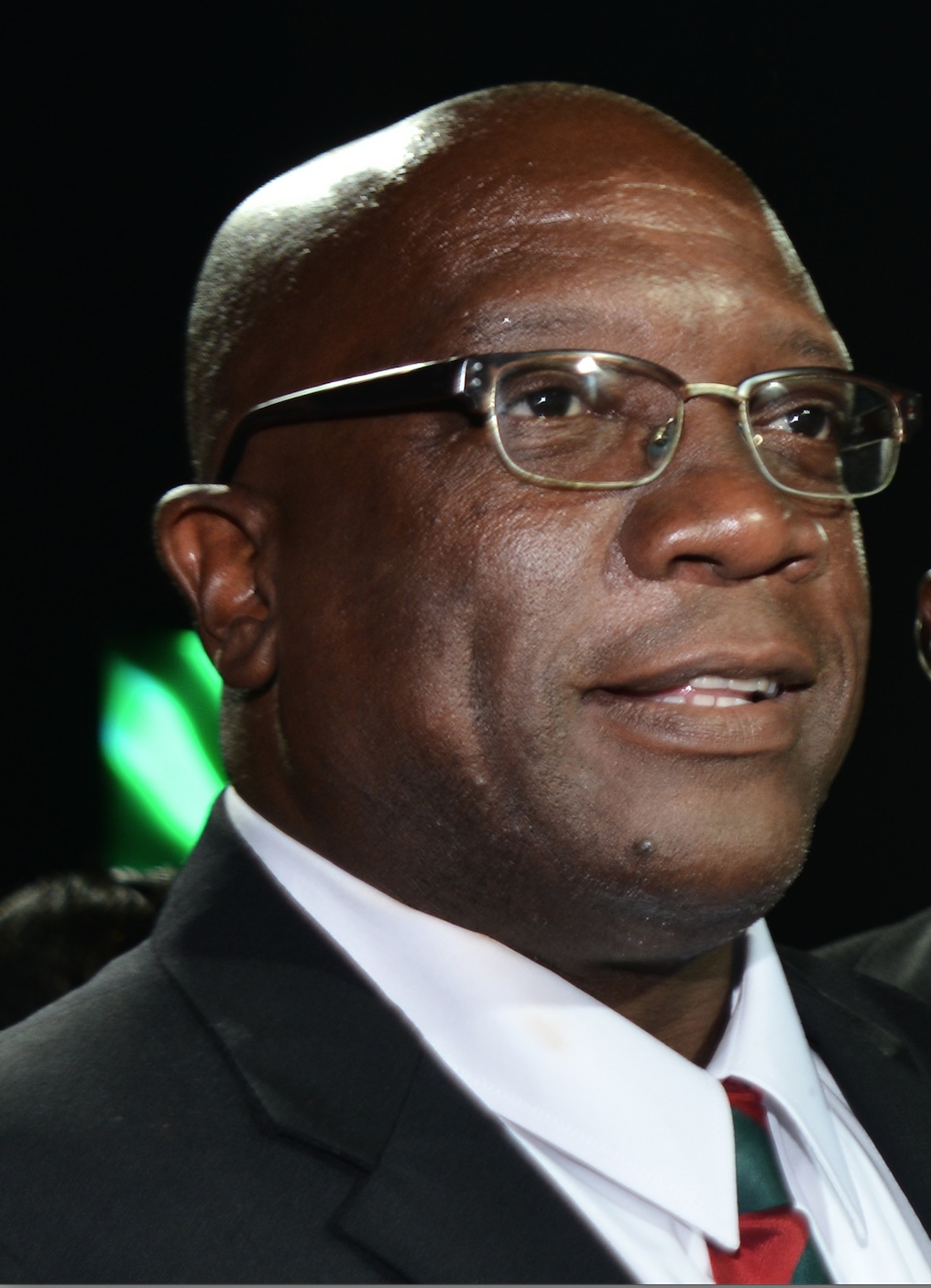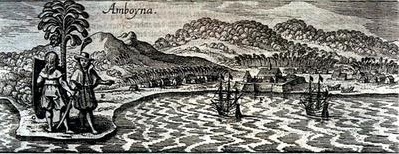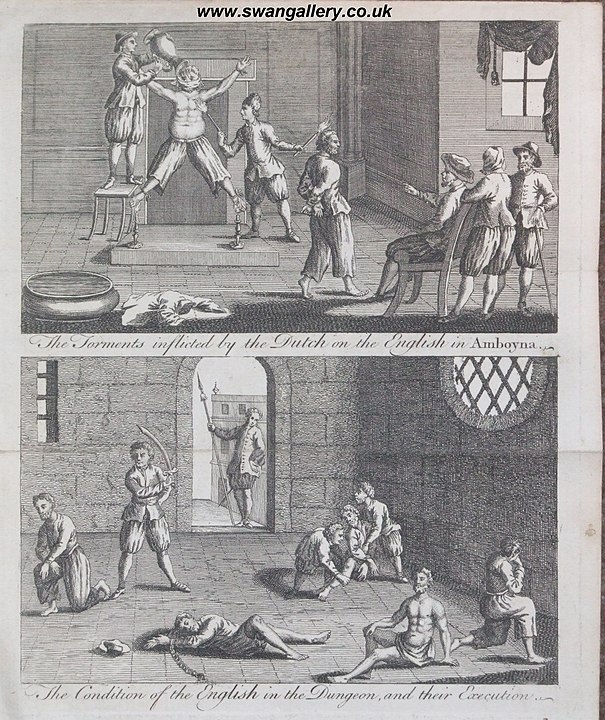In 1623, by far the most important development in imperial geopolitics was a confrontation the officials of the Dutch East India Company (VOC) had in Amboyna (Ambon) in the Spice Islands with the handful of English East India Company (EIC) officials there. After a torture-based kangaroo-court trial of all the local EIC officials, the VOC people executed ten of them. This incident became known in England as the “Amboyna Massacre” and had numerous longlasting repercussions, which I shall examine briefly here.

In those early decades of the 17th century CE (as now?), small islands distant from Europe were proving to be pivot-points for political developments of truly global impact. The other major development in geopolitics that occurred in 1623 was the seizure by English colonizers of most of the West Indies island of St. Kitts. There, and on the island of Barbados to its south which English colonizers seized in 1625, the English would soon thereafter pursue the two key colonial practices of that era by:
- eliminating the presence of the indigenous Kalinago people by genocide and expulsion, and
- establishing large agricultural plantations to be worked by a constantly-imported stream of enslaved workers brought in from lands far away, a high proportion of whom were literally worked to death.
But those developments still lie a few years ahead. So for this year’s bulletin I shall focus on the Amboyna Incident. Though first, perhaps, I should note that in the continuing Topkapi Palace Follies, 1623 saw the displacement (for the second time) of Sultan Mustafa I and his replacement this time around with another nephew, Murad IV. Murad (seen at right, later on and bearded) was 11 years old and effective power was once again wielded by his mother Kösem Sultan. The Ottomans also suffered losses to the Persian Safavid empire in 1623, including Baghdad.
Much of what I write below about the Amboyna Incident is based on Ch. 4 of William Wilson Hunter’s 1907 book, The European Struggle for Indian Supremacy in the Seventeenth Century, hereafter WWH. WWH seems to have been a typical Empire-loving English historian of his day and to have had good access to the records of the EIC. Throughout the book– which is available both online and in poorly produced print reproductions– he also expresses quite a lot of admiration for the “vigor” and capabilities of the Dutch colonizers of that era. His writing is often vivid and insightful and has some fascinating footnotes, though it is not well-organized. Sigh.
The Amboyna Incident
By 1623, the Dutch VOC already had a sizeable continuing presence in the “Spice Islands” of the Banda Sea, which came under the “jurisdiction” of the VOC Governor-General’s headquarters in Batavia (present-day Jakarta), around 1,000 miles away. The English EIC had earlier hoped to be the other “insurgent” European power in the Indian Ocean as it and the VOC contended to replace the trade networks that Catholic Portugal had built all around the Indian Ocean over the preceding century. (Both England and Netherlands were Protestant powers.) But by 1623 it was clear that in the Spice Islands of today’s Indonesia, whose major export products commanded hugely profitable markups in the European market, the English were already significantly outmanned, outgunned, and outshipped by the Dutch; and the attentions of the EIC had already shifted toward building up their presence on the coasts of the Indian subcontinent, not the Spice Islands.
In Amboyna and its immediately neighboring islands, the 18 EIC representatives/ warehouse managers were hanging on by a thread. And the VOC’s ruthless outgoing Governor-General, Jan Pieterszoon Coen, was determined to cut that thread. WWH wrote (pp. 114-15) that in January 1623, shortly before leaving his position in Batavia, Coen wrote to local VOC officials in the Banda Sea– known as the Clove and Nutmeg Archipelago– that they should continue to be harsh with the English:
“Trust them not,” [Coen] said, “any more than open enemies … not weighing too scrupulously what may fall out.” His farewell instructions merely reiterated the principles on which he had always insisted. “Trust the English no more than a public enemy ought to be trusted,” he wrote…
By the beginning of 1623 the Dutch found themselves completely masters of the Clove and Nutmeg Archipelago. At the principal clove island, Amboyna, they had, according to the English statement founded upon depositions on oath, a fortress garrisoned by two hundred Dutch soldiers, with three or four hundred native troops, including some thirty Japanese, and further protected by eight vessels in the roadstead. The English numbered eighteen men, scattered between five small factories [warehouses] on different islands, very badly off, with a few slaves, “just six and all boys.” In their house at Amboyna only three swords, two muskets, and half a pound of powder were found. The nearest English support was the Banda agency, at a distance across the sea, and containing but nine of their countrymen. English ships seldom came to Amboyna, and not one was then near. Our [EIC] president in council at Java had in fact resolved to withdraw the petty English factories at Amboyna and throughout the Clove and Nutmeg Archipelago. He had even arranged with the Dutch governor-general for their transport to Batavia in Holland ships. In February, 1623, orders to this effect were on their way from our president in Batavia to Amboyna.
They arrived too late.
The VOC’s “governor” on Amboyna was a guy called Herman van Speult. On February 11, he started interrogating one of his Japanese mercenary soldiers who had been seen consorting too closely with some English sentries the day before. Here’s WWH, pp. 116-17:
Van Speult put the Japanese soldier to the torture, and after he had “endured pretty long,” wrung from him an accusation against the English… Eight or nine other Japanese soldiers in the service of the Dutch, whose names he had mentioned, denied the plot, but were tortured on that and the following day, until a complete story of treason was evolved. “Wailing and weeping by reason of their extreme tortures with burning, they were carried by slaves to prison, for it was not possible of themselves to go on their feet.” Such was the statement made by the steward of the Dutch factory regarding the affair.
The handful of English, ran the improbable tale, had solemnly sworn on New Year’s Day to seize the fort upon the arrival of an English ship, or during the absence of the Dutch governor..
Van Speult then easily arrested the EIC’s chief agent in Amboyna, Gabriel Towerson, and all the other 17 EIC Englishmen in Amboyna and the neighboring islands; and he subjected them to harsh tortures including waterboarding and burning their body parts with candles in an effort to extract confessions from them. Interestingly, as WWH remarks on throughout this chapter, Dutch law at that time required confessions from the accused if they were to be found guilty of any crime– and if torture was required in order to extract a confession, then it should certainly be used. (Though apparently a reiteration of the confession was also required to made 24 hours after the torture had ended– and that requirement, WWH wrote, Van Speult’s men had failed to meet.)
To be honest, I am still trying to get my head around the idea that a bunch of colonial plunderers and occupiers, having entered and completely taken over a piece of distant land not their own, should have had (or professed) any kind of adherence to any kind of “rule of law”… But anyway.
Here’s how WWH described– based on numerous testimonies and court documents produced over the several years that followed– what happened next (pp.119- 21):
[The Dutch prosecutor’s] evidence consisted entirely of confessions wrung from the accused by torture. The ransacking of the English factories yielded not a single incriminating letter, or other corroborative piece of testimony, as is proved by the answer of Joosten, the Dutch officer who examined the papers. The Dutch began with John Beaumont and Timothy Johnson. Beaumont, an elderly man for India and an invalid, was left with a guard in the hall, while Johnson was taken into another room. Presently Beaumont heard him “cry out very pitifully; then be quiet for a little while, and then loud again.” Johnson long refused to confess, but after an hour he was “brought forth wailing and lamenting, all wet and cruelly burnt in divers parts of his body”…
From February 15th to 23d the cruel process went on. According to the English statements, the prisoners, even while confessing under the torture, declared in the same breath that they were not speaking truth. In the case of Collins, the “fiscal,” or prosecutor, forced leading questions upon him, till one of the Dutch themselves exclaimed: “Do not tell him what he should say, but let him speak for himself.” John Wetheral having been four times tied up, they were at length obliged to read out to him the confessions of the other victims until the poor wretch merely “answered yea to all.” He “prayed them to tell him what he should say or to write down what they would; he would subscribe it”…
Interestingly, the VOC “court” sitting in Amboyna kept minutes of its proceedings. Those omitted any mention of the torture. But in the years that followed, as the Incident became a huge issue in Anglo-Dutch relations, a couple of further investigations into the Amboyna “trial” were held back in The Hague. In those investigations, the members of the VOC’s Amboyna council, who had sat as judges in the 1623, “acknowledged on oath that twelve of the English were tortured by water and two of them also by fire, but stated that one (Beaumont) was only tortured a little on account of his age and feeble health. The judges also pleaded in their defence that the torture was in no case extreme, indeed of a ‘civil’ sort.” (WWH 122.)
WWH tells us, pp. 122-23, what he had learned (nearly 300 years later) from reading testimonies from both Dutch and English eye-witnesses:
The accused man was hoisted up and tied spread-eagle fashion in a doorway. In the water torment “they bound a cloth about his neck and face so close that little or no water could go by. That done they poured the water softly upon his head until the cloth was full up to the mouth and nostrils … till his body was swollen twice or thrice as big as before, his cheeks like great bladders, and his eyes staring and strutting out beyond his forehead.” It was the slow agony of bursting, joined to the acute but long-drawn-out agony of suffocation. In the fire torture, they held lighted candles beneath the most sensitive parts of the body – under the armpits, the palms of the hand, and the soles of the feet. Emmanuel Thomson, like John Clarke, it was said, had no surgeon to dress his burnt flesh, so that no one “was able to endure the smell of his body.”
To the torture by fire and water, admitted by the Dutch, the English accounts add “the splitting of the toes, and lancing of the breast, and putting in gunpowder, and then firing the same, whereby the body is not left entire, neither for innocency nor execution. Clarke and Thomson were both fain to be carried to their execution, though they were tortured many days before.” But the Dutch admissions suffice.
Then this:
On February 25, 1623, or February 23d (for there are discrepancies as to the date), the prisoners, with certain exceptions, were condemned to death. The English from outlying factories, who had not even been at Amboyna at the time of the alleged plot, were released; three others were allowed to draw lots for their life; and in the end the elderly Beaumont and the terrified Collins were sent to give evidence at Batavia as “men condemned and left to the mercy of the governor-general.”
English-WP informs us that the executed were ten Englishmen, nine Japanese, and one Portuguese– with the Japanese and Portuguese all having been “traitorous” employees of the VOC. Then this:
On 9 March 1623 they were beheaded, and the head of the English captain, Gabriel Towerson, was impaled on a pole for all to see. The incident ended any hope of Anglo-Dutch cooperation in the area, a goal that both governments had been pursuing for several years, and marked the beginning of Dutch ascendancy in the Indies.
The Englishmen who had been pardoned and acquitted then sailed to the VOC headquarters at Batavia to seek redress for their executed colleagues, and finding none they traveled with the EIC’s factor at Batavia to England, to plead their cause there. Then, this:
Their story caused an uproar in England. The directors of the EIC asked that the English government demand reparations from the VOC and exemplary punishment of the Amboina judges from the Dutch government.
According to the English ambassador Sir Dudley Carleton, the version of events as he presented it also caused much anger at the VOC in Dutch government circles. However, the VOC soon presented its version of events which contradicted the English version in essential respects. The Dutch States General [parliament] proposed a joint Anglo-Dutch commission of inquiry to establish the facts, but the suggestion was rejected by the English as too time-consuming. The Dutch did not want to execute the culprits of the torture and executions summarily as the English wished, so the States General commissioned an inquiry by delegated judges from the highest courts in the Dutch republic to investigate the matter. The Amboyna judges were recalled from the East-Indies and put under house arrest.
The trial progressed slowly because the court of inquiry wished to cross-examine the English witnesses. The English government balked at this demand because it felt it could not compel the witnesses to travel to the Republic. Besides, as the English based their case on the incompetence of the court to try employees of the EIC (according to the English interpretation of the Treaty of Defence), the executions were ipso facto illegal in the English view and, therefore, constituted a judicial murder. This contention could be decided without an examination of the witnesses. The Dutch, however, maintained that the court at Amboyna had been competent and therefore concentrated their inquiry on possible misconduct of the judges.
The English witnesses traveled to the Dutch republic in 1630… They were made available to the court under restrictive conditions. The draft-verdict of the court (an acquittal of the accused) was presented to the new English king Charles I in 1632 for approval (as agreed beforehand by the two governments). It was rejected, but the accused judges were released by the Dutch authorities.
In 1654, Towerson’s heirs and others received £3,615 and the EIC £85,000 from the VOC in compensation for the events at Amboyna.
Some afterthoughts on Amboyna
- After Amboyna, the EIC never tried again to build a colonial presence in the area of those Spice Islands, though they did come to “Malaya” in 1786. After 1623, the EIC retreated instead to the shores of the Indian subcontinent and adjoining bodies of water.
- That left the VOC and Netherlands as the only significant European colonial presence in the area that later became Indonesia. (Portugal was already in steep decline there.) Coen had already, in his 1623 “departure letter” to his successor at Batavia, laid out his vision of what the VOC should do with the islands. This vision, as represented by WWH on pp.158-63, was almost exactly analogous to what the English were doing in the islands of the West Indies: genocide and displacement of the indigenes and the establishment of large-scale agricultural plantations worked by people enslaved from distant communities.
- The insistence by the Dutch on some form of complex legalism to justify the actions of the VOC officials in Amboyna was notable. At p.146, WWH expresses this intriguingly Orientalist sentiment: “Among Eastern races the king or governor was both ruler and judge, and the early European settlements in Asia found themselves compelled firmly to unite all functions, executive and judicial, in the hands of one man or body of men.” I just wonder who or what was compelling them?
- In English politics, the Amboyna Incident remained a subject of great public concern for many years after 1623. WWH hints that this furore may even have helped take King James to his grave in 1625.
- WWH’s account also indicates several intriguing leads about the relationship that each of these large (and well-armed) trading companies had with the government of its home location. At p.132, WWH writes that in July 1624, King James, “promised to make stay of Dutch vessels if satisfaction were not given, and even offered to become himself a shareholder in the Company, and to allow its ships to sail under the royal standard. This offer of greatness thrust upon it, the Company respectfully declined.”



